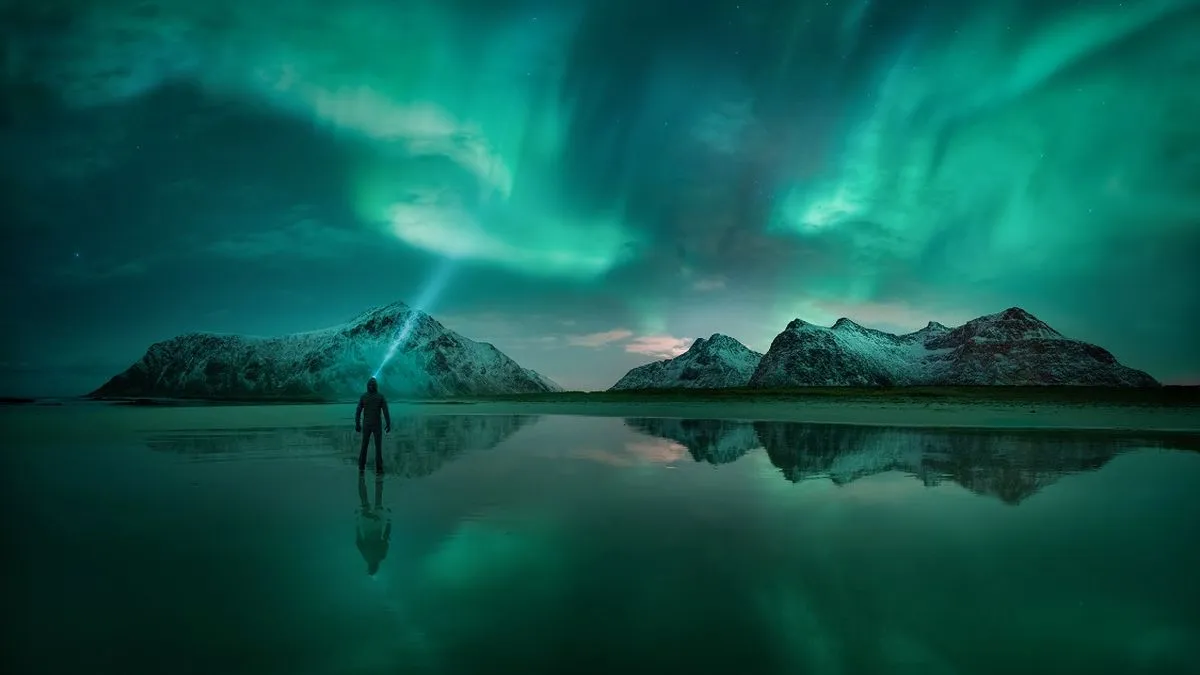The science behind the Northern Lights
Tuesday 28 December 2021

The Northern Lights, or Aurora Borealis, are one of the most stunning spectacles people can see on earth and offer an ethereal experience to any who sees them. Many people have ‘seeing the Northern Lights’ on their bucket list and choose to take holidays such as a Northern Lights cruise to tick that off.
But what actually are the Northern Lights? What’s the history and mythology behind them and how do the Northern Lights work? We answer all of these questions in this article.
What are the Northern Lights?
The Northern Lights are a phenomenon that occurs in the sky, usually observed over the North Pole within the Arctic Circle, although occasionally can be seen south of it. They are most commonly seen in Norway, Sweden, Iceland, Alaska, Canada and Russia. The lights can appear at any time of day but are most easily seen in the night sky. They tend to be green in colour, however, pinks and even more rarely reds, violets and whites can also be seen in an especially strong display.
The Northern Lights aren’t actually entirely unique, as we get Southern Lights, known as Aurora Australis, as well. However, as these are centred over the South Pole, far fewer people are able to see them.
READ MORE: The Top 5 Countries to Witness the Northern Lights

The History of the Northern Lights
Human beings have spent thousands of years gazing up into the skies above them at these dancing bands of colour, wondering what they meant. Different cultures have developed different myths and stories surrounding these natural phenomena, meaning that the Northern Lights go beyond just science. The lights are closely bound to culture, religion, mysticism and remain so all of these years later.
Depictions of Aurora Borealis have been traced as far back at 30,000 B.C. in the Cro-Magnon cave paintings. It wasn’t until 2,600 B.C when we see the first written citing. In China, it is said that Fu-Pao, the mother of the Yellow Empire Shuan-Yuan, noticed ‘strong lightning’ around Su, a star. The writing notes how the light illuminated the whole area.
It was Galileo Galilei who first coined the term “Aurora Borealis” in 1619 A.D. The name derives from Aurora – the Roman goddess of the dawn – and the Greek name for north wind, Boreas. Originally though, he thought that they were a reflection of the sun from the atmosphere.
However, in the 1200s there are descriptions of the spectacle in writing from the Vikings. The work, “Kongespeilet” goes against other European thoughts on the lights at the time. Kongespeilet describes it as a natural phenomenon, a theory that was not matched for another 500 years. Norwegian Vikings also believed in a sky bridge between Earth and the gods, which could be early concepts of the Northern Lights. They even had a god for them, Heimdall.
What causes the Northern Lights – according to myth
As you can see, experiences of the Northern Lights appear to go back as far as human history, and many different cultures have their own mythology linked to them. We explore some of the most interesting below.
European Mythology
Sightings of the Northern Lights in Europe are limited to those countries closest to the Arctic Circle, though they have been known to descend upon some parts of England, but rarely further. To be visible so far south there would need to be intense solar activity, resulting in red Auroras.
At the time, when there was of course no documentation of such a thing, and given how rare the occurrence was, it is no surprise that these events could cause some concern. In France and Italy, they believed that the lights were a bad omen, foreshadowing anything from war to a plague. Whereas in the United Kingdom it is said that the skies turned red weeks before the French Revolution, making them appear to be a warning of the upcoming events.
North American Mythology
There are two popular beliefs from North America about the meaning of the Northern Lights. The first comes from Inuit tribes who would call the Lights ‘aqsarniit’, meaning ‘to play with a ball’. These people believed that the lights were the spirits of the dead playing an ancient form of football with the head of a walrus.
The other relates to the Cree. One of the largest groups of First Nations in North America, the Cree’s thoughts on the Lights directly related to their beliefs. They believed in the circle of life and as such, saw the lights as the dead that had not been fully separated from their family and loved ones. They would come back again and again in an attempt to communicate with those they left behind.
Eastern Asian Mythology
Like in Europe, sightings of the Northern Lights in China and Japan are rare. But when they did occur, the Chinese in particular were in awe of the glowing patterns that would illuminate the sky. The lights are tied to many Chinese legends that relate to dragons, as it is viewed that a good and bad dragon would be fighting and breathing fire (the colours) at each other. The Japanese believe that if a child is conceived beneath the Northern Lights, then they will be attractive, intelligent and receive good fortune.
READ MORE: Everything you need to know about the Northern Lights

How are the Northern Lights formed – according to science
What are the Northern Lights? How do the Northern Lights work? Why do the Northern Lights happen? These are questions that bewildered humankind for thousands of years.
Aurora displays (both in the north and south) begin their journey 93,000,000 miles away on the surface of the sun. The sun creates something called the solar wind, which carries solar particles (protons and electrons) across space. Auroras occur when those solar winds reach Earth’s magnetic field.
Imagine the magnetic field as a forcefield around the Earth, and when the solar winds hit it at high speed, they are forced to divert their path, wrapping around the atmosphere and slowing down their journey to the Earth’s surface. As the particles within the protons and electrons reach Earth’s atmosphere, namely nitrogen and oxygen, they have a reaction causing the unique lights we see.
No one photo of the Northern Lights is the same. Across the internet, there are brilliant examples of this beautiful event, each with different colours and shapes. But why are they all different colours? The colour of the Northern Nights depends on what gases the particles from the sun collide with. On top of that, it depends on the altitude where the collision happens.
Green: Oxygen - up to 150 miles above Earth’s surface. The most common of Auroras are green. This is because the majority of collisions happen at this distance. Our eyes are actually better equipped to pick up the colour green than others, so if you are looking on a northern lights cruise but only see a faint whisper of the lights, get the camera out and take a picture. Chances are it will be able to capture much more of it than the naked eye.
Red: Oxygen – more than 150 miles above the Earth’s surface. Red is most commonly associated with some really intense solar activity. Oxygen is less concentrated at this height, meaning it moves more vigorously than oxygen elsewhere, resulting in the red colours.
Blue and Purple: Nitrogen – up to 60 miles above the Earth’s surface. Blue and shades of purple occur rarely and are dependent on very high solar activity. When the collisions with nitrogen are so close to Earth the particles glow in a bluish-purple.
READ MORE: Discover top Reykjavik attractions to visit
There is no doubt that the Northern Lights are one of the most spectacular sights on Earth. Deservedly a natural phenomenon, we may not be able to see them here all that often in the UK, but you can by booking a Northern Lights cruise. Pack your camera, some warm clothes and prepare yourself for an unforgettable experience. Alternatively, try your luck on a Canada cruise holiday or Greenland cruise which will take you to places where the Northern Lights might appear.
For more tips, guides, and advice, make sure to visit our blog page.


